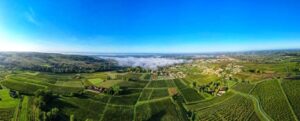MORE GREAT ATTRACTIONS TO DISCOVER SOUTH OF BORDEAUX
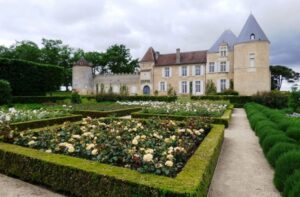
Our travels in this region revealed far more than we had expected. There is such a wealth of great places to visit just south of Bordeaux, ranging from world famous vineyards such as Château d’Yquem, while others are much less well-known, and a few hardly known at all outside the region. There are a great number of fortified châteaux, many of them impressive ruins, while some are still lived in today. There are pretty bastide villages, imposing cathedrals, and the most surprising discovery of all, a small, Gothic-style chapel with an exquisite Italianate Baroque interior, located in a tranquil rural setting in the deep heart of the Tarn et Garonne countryside.

As previously mentioned in the last couple of posts, we were heading up to Bordeaux by way of the Tarn et Garonne region, which we already knew to some extent and had always planned to make a more in depth visit one day. We were aware that the area had many treasures to discover, but so many more were suggested to us en route, sometimes by local tourist bureaux and occasionally by hoteliers or fellow-travellers.

The Église de Saint-Pierre de Lachapelle sits on the edge of the small village of Lomagne. One of the very helpful staff at the tourist bureau in the small town of Auvillar—which I talked about in an earlier blog—urged us to make a detour to see this extraordinary chapel, promising us that we would never have seen anything like it in France. With that tempting recommendation, we headed 40 kms south of Auvillar.
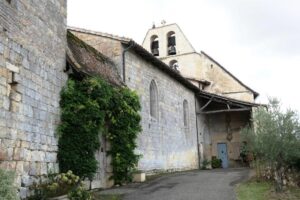
The chapel itself is located on a small hill surrounded by rolling hills, next to a château, whose owner acts as custodian of the chapel. Its exterior is a somewhat austere, simple Gothic style, but when you push open the heavy timber doors, nothing prepares you for the dazzling sight of its Baroque interior that verges on the Rococo, with gilded decorative timberwork, painted faux marble Corinthian columns topped with ornamental pots of fire and trompe l’oeil wallpaper. There is gold, gold and more gold everywhere, crystal chandeliers and huge paintings on religious themes in beautifully sculptured Rococo frames.
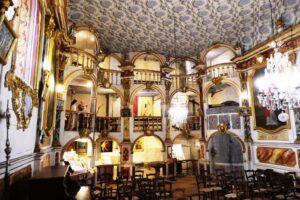
The very hospitable château owner who showed us around explained that the history of this unique chapel dates back to 1746. When Jean-Baptiste Goulard, who had studied in Rome, arrived as priest, he was dismayed to find that the tiny church could hardly accommodate his parishioners. He decided to employ a master carpenter cabinetmaker to extend the space by adding 3 internal galleries along the rear wall of the single nave.

Master artisan craftsmen decorated the church in the opulent Baroque style that Goulard had so admired in the magnificent churches of the Vatican and Rome. The galleries are both concave and convex in shape, and resemble the alcoves found in Italian theatres of the era. One rather odd feature is that the galleries are not reserved for an organ, but rather, both floors were instead designed for the parishioners. This unique chapel is indeed a small jewel.

We then headed further north to the medieval town of Bazas, whose main attraction is the 13th century Gothic-style Cathedral of Saint Jean-Baptiste in the central square. It is classified as a World Heritage site by UNESCO as part of the pilgrimage route to Santiago de Compostela. On the Place de la Cathedrale, a large market, said to be one of the loveliest in the region, takes place on Saturday mornings. The 16th century Place des Arcades served to protect merchants displaying their goods at the foot of mansions, such as the House of the Astronomer, the Palace of the Presidial (Court of Justice), and the Hotel Andrault.

Just next to the Tourist Office is the Halle de Bazas, which dates from 1485, and the old Hotel de Ville which houses the municipal museum of Bazas that has artifacts from 2,500 years of the city’s history. Take a walk along the town’s 6th century ramparts and you will have a beautiful view of the Sultan’s Garden below that has a magnificent rose garden.
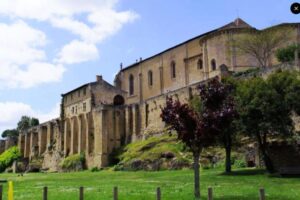
Barely 19 kms further north from Bazas lies the medieval village of Saint Macaire. Surrounded by ramparts, the village is a remarkable medieval architectural ensemble, with many listed historic monuments, such as the arcaded square of Mercadiou and its beautiful medieval houses dating from the 13th to 16th centuries.

There are a number of Renaissance houses adorned with mullioned windows, and you can’t miss seeing the former Henri IV coaching inn that has an impressive façade. In the 18th century, underground galleries were dug to extract the stone transported to Bordeaux for the construction of its important buildings.

On the edge of the ramparts is the church of Saint-Saveur, once part of a former Benedictine priory. An impressive 14th century clock tower marks the entrance into the village.

A little further towards Cadillac is one of the most impressive sights of the area, the ruined Château de Budos. Built by a nephew of Pope Clement V, he remodelled and expanded it around 1306 from the original château built by his uncle. In layout, it resembles the neighbouring fortress, the Château de Villandraut. Budos is rectangular in plan. A vast U-shaped building has a courtyard protected by a high wall with towers at the corners. The north-east wall seems to have been raised several times.

King Henry VI of England took possession of Budos in 1422-3, and it eventually passed to Henry’s son, the Duke of Gloucester. It passed back and forth over the next couple of centuries between the French and English crowns. It was sacked and pillaged in 1652, and although it stayed nominally under the ownership of the La Roque family, it fell into ruin during the French Revolution, and much of its stone was sold by the state to a builder. Today, it’s an atmospheric ruin that dominates the local landscape.

About 30 kms south of Bordeaux is the small, picturesque medieval village of Rions. Nestled in the heart of the vineyards, Rions was the capital of ancient Aquitaine. This small stronghold witnessed battles during the Hundred Years’ War between France and England, and the remains of its defensive past is very evident, such as the Lhyan Tower and Keep which guard the entrance into town.
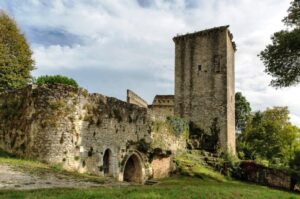
This formidable Tower and Keep were built in 1295 and reinforced again in 1330. There are numerous fine stone buildings to see, such as the impressive Hotel de Ville and numerous townhouses. Well worth a detour and a leisurely stroll.

Almost the first thing many of us think about when they hear the word ‘Bordeaux’ are the wonderful vineyards—some the world’s greatest—in the district. The very names of Châteaux Margeaux, Haut-Brion, Lafite Rothschild, Mouton Rothschild, Latour, Saint-Julien and d’Yquem are enough to send any wine lover into ecstasies of anticipation! Aside from doing some basic research at home before you plan a trip to Bordeaux, the quickest way to find out which of the great wine houses accept visitors, and perhaps offer tours, is to make a visit to the excellent Tourist Bureau in Bordeaux. They can tell you all the need-to-know info. about opening times, and whether or not individuals can visit, or only as part of a group, cost of visits, if any, and give you a map if you’re driving.
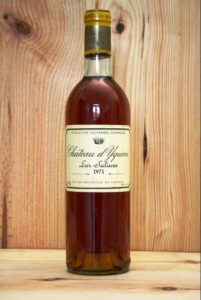
Coming up to Bordeaux from the south you pass through the Sauternes area, and of course, to wine lovers, that immediately says ‘Château d’Yquem’, one of the most famous wines in the world, not just Bordeaux. It is the only sauternes with the Premier Cru Supérieur status. It is possible to visit the 400 year old Château d’Yquem, Monday to Sunday, and all visits are guided by Château staff. However, visits are not free, and prices range from 84 € per person to 300 €, depending on what tasting tour you book.
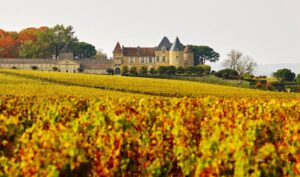
Located on top of a small hill, it seems that Château d’Yquem does in fact look down over on the Bordeaux countryside. Its exalted reputation dates back to the Middle Ages when it was owned by the King of England, who was also the Duke of Aquitaine. After the region was annexed to the Kingdom of France by Charles VII, the château passed into the noble Sauvage family in 1593, who built the château that we see today. It served as a military hospital in both World Wars.
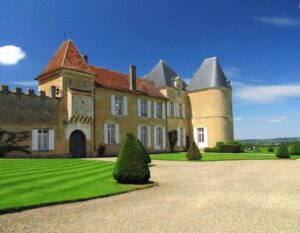
In 1968, the château was run by Comte Alexandre de Lur-Saluces, a minority owner. Under his leadership, tractors replaced horses, collapsing cellars were renovated, and unused acreage was planted, with production in good years reaching 100,000 bottles and sales about US$10 million. Following a bitter family feud, Comte Alexandre’s brother Eugene sold part of his share to LVMH/Moet-Hennessy-Louis Vuitton, who kept Comte Alexandre on as manager of the estate.

In 2006, Dior (owned by LVMH) and Château d’Yquem created a skin care product range made from the sap of the Yquem vines, called L’Or du Vie La Cure. In July 2011, an 1811 bottle of Château d’Yquem sold for US$117,000 at the Ritz Hotel, London to a private collector, to become the most expensive bottle of white wine ever sold.

There is a lot to see in this region, yet the gentle, tranquil landscape demands a leisurely pace. Not only to enjoy the beautiful, lush countryside, but you will pass by ruined châteaux, charming medieval villages, vineyards and their often impressive châteaux. You need to allow time to explore the famous as well as previously unknown treasures that you will discover once you’re in the region, and of course, the produce for which the area is so famous!
